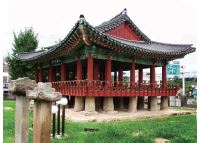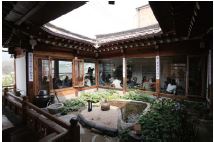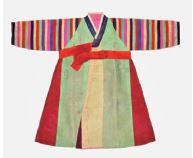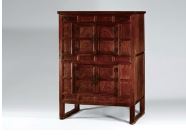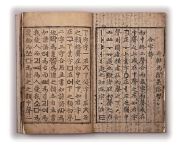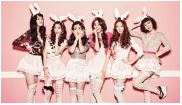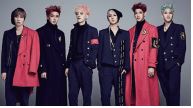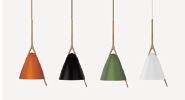
Contemporary Traditions: South Korea’s Emerging Design Identity- An Exploration among Professional and Academic Design Experts Aged 30-50
Background Through an institutionalized approach the Korean design industry has been transformed strategically from imitator to innovator. One of the milestones in this process has been the formulation of a national design identity known as K-Design DNA. Since no clear consensus exists within academia regarding the nature of Korean design, this research examines key characteristics oft the emerging Korean design identity based on the hypothesis that a considerable gap exists between professional practice and institutional, orchestrated efforts.
Methods Insights from qualitative research among leading representatives of the Korean design community were analyzed and set in relation to the institutionally formulated design identity. The research identifies core topics, isolates gaps, and provides solutions to address these issues.
Results The emergence of the Korean design identity is currently taking place in both a top-down approach and a bottom-up movement. Efforts are being made from the governmental and institutional side to define an identity, and vibrant discussions are being held in the design community around the nature of this identity.Within the design community,a strong focus exists on intangible cultural values and cultural phenomena as cornerstones of the Korean design identity that has not yet been appropriately addressed by the involved institutions.
Conclusion Overall, the findings indicate that there is a clear requirement for a reevaluation of the institutional approach. The study suggests three possible interlinked directions to articulate the national design identity in a more holistic, concise manner, and to synthesize the top-down approach with the bottom-up movement.
Keywords:
Design Identity, Intangible Values, Design Process1. Introduction
South Korea has seen unprecedented economic, cultural and technological advancements in the past 50 years. The “Miracle on the Han River” propelled the country out of the Global South1) and into the echelons of the Global North. Korean popular culture, also known as K-Pop is sweeping around the globe, and Korean brands are among the most valuable and recognizable in the world. In this socio-cultural-economic context, influenced by global and local trends, Korean design had good general conditions to evolve accordingly.
Korean culture is in the spotlight. Korean design, however, and the Korean design identity in particular are still sparsely discussed in international design studies. Although, there are a number of researchers who examine Korean design artifacts and exhibitions (An & Choi, 2012), describe and evaluate strategic policies in this context (Chung, 1993; Chung, 1998; Cho, 2004; Kim, 2004; Choi, 2014, Chung, et al. 2016) and explore philosophical and ideological implications from a theoretical perspective (Beckett & Kim, 2014; Beckett & Kim, 2015), there are still very little primary researches conducted among expert designers, nationally and internationally, regarding the Korean design identity.
2. Background& Hypothesis
According to Chung (1993, 1998) and Cho (2004) the Korean design industry has been transformed strategically from imitator to innovator. The industry has advanced through a variety of measures including four five-year design promotion plans supported by the Korean Institute of Design Promotion (KIDP) and its predecessors. The aim was and still is to develop Korea as a design pioneer, support design research, stimulate private investments, and raise the general awareness of design. One of the most recent milestones in this context was the formulation of a national design guideline in 2012, also referred to as K-design.
K-design formulates a national design identity “K-design DNA” by compiling examples from traditional architecture, furniture, ceramics, fashion design and humanistic spirit/philosophy, to modern design examples from electronics, automotive, furniture, package, and material and surface design.
Evidently, political initiatives, and public and private investments have had very positive impact on the design industry. In the years 2005 to 2009 e.g. the Korean design industry’s gross economic output grew from 102 billion won to 148 billion won, equaling a 55% increase (Ahn, et al. 2012; BusinessWeek, 2013). In 2011, Seoul became a UNESCO city of design and to date over 170,000 jobs have been created in the design industry (UNESCO, 2011; MIT, 2014). Samsung (electronics), LG (electronics), and Hyundai (automotive) employ thousands of designers in communication-, product-, service- and experience design, and are among the largest contributors to Korean exports and its foreign trade balance. (Samsung, 2014; Trading Economics, 2016)
While the above stated numbers, growth rates and contributions of the Korean design industry are – without doubt – outstanding achievements, there seems to be no clear consensus on Korean design, its identity and on how innovative, sustainable and future-focused Korean design truly is. (Vandeerbeeken, 2010; reddot, 2006 & 2015; Wilson, 2015).Choi (2014) describes the aim of the K-design initiative from 2012, also known as K-design DNA, in line with previous design promotion plans, as a mere tool for economic growth, and criticizes the centralized approach as well as the vague and ambiguous definition of the Korean design identity. In addition, there has been virtually no primary research conducted among expert designers in relation to the Korean design identity. For these reasons, we hypothesize that there may be considerable disparities between official reports, orchestrated efforts and actual perceptions within the industry itself.
3. Aims
With this study, our aim is to begin the work of closing the gap between professional design practice and academic design studies. By exploring its local socio-cultural context, gaining insight into expert designers’– on the professional side as well as on the academic side – thought processes, and sharing these findings, we hope to contribute to a more holistic understanding of the contemporary Korean design identity, and the values it is based on. The results may not only add to the body of knowledge in design studies, but also inspire further discussion in the design industry and contribute to achieve enhanced environmental, social and cultural performance in and through products and services.
4. Method & Participants
In recognition of the qualitative nature of the research subject this study applied a qualitative hybrid approach. Firstly, the researchers immersed themselves within the socio-cultural context for an extended period of time to observe, to identify beliefs and customs, and to discuss cultural particularities.
Secondly, literature research was performed, and in-depth interviews conducted. 12 expert designers and CEO’s in their late 30s to late 40s were interviewed as well as eight design professors from universities in Seoul with ages ranging from mid-40s to late 50s. The rationale for the selection of professional designers and design academics lies in the aim to help closing the gap between professional practice and academic studies. Relatively wide age ranges were targeted to verify the findings across generations. The interviewees were selected from representative, internationally acclaimed and multi-awarded (product, service, and strategy) design agencies, as well as from leading design universities in South Korea. The semi-structured interviews took about one to two hours each and were recorded.
Thirdly, the interviews were transcribed, analyzed and the results compared. Keywords were identified based on multiple nomination and emphasis from the interviewees. The keywords were then extracted, subsumed in categories, visualized, and the findings examined in relation to the previously conducted content and literature research. The research results are described in the following paragraphs with names being anonymized at the request of some of the participants, and to allow a greater focus on the provided content.
5. Research Result Analysis
The in-depth interviews conducted among Korean expert designers and design scholars provided valuable insight in ongoing discussions within the Korean design community.
The general consensus was that there is no clear or fixed Korean design identity yet, though for many there have been considerable developments in recent years. When asked directly about Korean design, for most interviewees it seemed to be easier to refer to it in relationand delineation to other (supposedly fixed) national design identities - namely German, Japanese, Chineseand US American design. Focusing on the East Asian region, Japanese design was described as confident, evolved, minimal, simple, clean, straight, arranged, and controlled. Chinese design on the other hand, was seen as colorful, fancy, bright, powerful, scaled-up, and less refined.
When asked about features and particularities of Korean design the most frequent answers were within the categories“culture” (14x), “vernacular feelings” (23x), “balance” (8x), “trendy and adaptive” (7x), “attention to detail” (4x), “story-telling” (3x), and “more than traditional” (18x) as listed below in <Table 1>. The category definitions were derived from the interviewee comments. The keywords represent direct citations.
The pictures below in <Table 2> show contemporary and traditional Korean designs that were either shown by the interviewees or mentioned during the conversations.
All interviewees agreed that traditional colors, patterns and materials (incl. figure) influence their conception of Korean design and are often part of theinitial solution space in their design process. The discussion in the community has two general lines of thought.
Firstly, Korean designers acknowledge the necessity of looking into the historical aspects of design. The idea here seems to be to start from traditional aesthetics (form, functionality, color, material, process) or behaviors (e.g. folklore)and to extrapolate how these aspects would have developed if Korea had not been under occupation from foreign powers and affected by conflicts with the Northern part of the peninsula for extended periods of time. One Interviewee claimed: "[…] Korean design history is a bit sad. As you know we were invaded and at war a few times, so we lost the time for design development […]"
Secondly, Korean designers ought to consider the socio-cultural context within design emerges in relation to (global) trends. Here, the idea is to focus on the present and consider elements in the contemporary culture that are unique, endemic, and inspire discussion and creativity. This is illustrated by what one interviewee described as “[…]part of our national psyche. There have been many horrible things in the past, but we have to accept them for what they are: part of our history – these events also made us who we are today [...]”.
The interviewees were unanimous in emphasizing the need to consider cultural roots and traditional values in design, but not to define its identity exclusively through these elements.When asked to further articulate these socio-cultural elements the interviewees referred to the concepts described above in table 1. Interestingly, most of the encountered terms to express indigenous or vernacular emotions do not have simple literal translations. They are rather multi-dimensional concepts, expressions deeply engrained in both traditional and contemporary Korean culture. The translations listed below in <Table 3> are based on the definition provided by the National Institute of the Korean Language, however, these translations do not describe the concepts in their entirety as commonly understood in contemporary Korean society (Lee, 1994).
Besides striving for a balance between “jeong”, “hon”, “deom”, “him” etc. expressed through their respective product-, service-, and strategy design projects, the interviewees pointed out the importance of the intellectual exchange with fellow colleagues in their design process - especially about these and other intangible concepts and cultural phenomena.
Not only are the artifacts’ aesthetics, function and sustainability influenced by these abstract, intangible and partly subjective concepts – in many cases the creative process itself depends on them. Here especially the “jeong” and like-mindedness between the team members was described as a decisive factor.
6. Discussion
An identity etymologically signifies sameness and is commonly referred to as who or what someone or something is. In a more holistic and philosophical definition identity is understood as what Hall (2000) describes as “constructed within, not outside discourse”, and as “more the product of the marking of difference and exclusion, than […] the sign of an identical, naturally constituted unity.” The construction of an identity or identification is seen as an ever-changing process - with a non-unified result that is constantly transformed by “intersecting and antagonistic discourses, practices and positions.”
In line with these thoughts it seems the current discussion in the Korean design community points towards an emerging design identity formed by a top-down approach as well as a bottom up “movement”. As described through the literature review and the analysis of the primary research results above, there are centralized, orchestrated attempts at defining and fixing a national design identity (top-down), as well as vibrant, diverse discussions within the design community itself (bottom-up) on what Korean design is.
While the present research suggests that the emergence of a Korean design identity is imminent, the questions remain how to best articulate this identity in a holistic and concise manner, and whether the design identity communicated by centralized institutions is congruent with important aspects suggested by the design community.
The K-design DNA, an initiative and website, launched by the Korean Institute of Design Promotion (KIDP) in 2012, is an attempt to formulate a Korean design identity or “Koreanness” by selecting representative “good designs” in the categories architecture (currently 23 selected design online), furniture (17), ceramics (20), apparel (24), humanities/intangible assets (10),fine arts (23), and industrial design (24). Interestingly there are currently very few modern or contemporary examples in each category on the K-design DNA website: architecture (2), furniture (2), ceramics (0), apparel (3), humanistic spirit(0), fine arts (3), and industrial design (24). Most remarkably there are no examples for modern/contemporary ceramics and no examples in the category of humanistic spirit that is allegedly aiming to show intangible values. The industrial design category includes three examples of digital content, but service design examples are entirely neglected. Overall the selection of both traditional and modern examples seems to be arbitrary as has been pointed out by Choi (2014) and Chung, et al. (2016).
Ultimately the K-Design DNA aims at reviving Korean traditions (Gimeno-Martinez, 2016) and attempts to links these traditions with contemporary, international trends, in order to appeal to overseas consumers (Choi, 2014). In the latter sense the K-Design DNA follows prominent examples of European design identities from Germany, Italy, Scandinavia and so forth.
As put forward by Rusten, et al. (2007) there are clear political, social and foremost economic benefits to be gained from associating products with a certain place (e.g. perfume from Paris) and creating so-called cultural products. It is important though in this place-product relationship construction that the place can only be appreciated by consumers “in relation to a wider system of meaning”. This system can only function by referring back to an individual’s referent system – that is a country’s identity is only understood in relationship to a person’s knowledge of that country and other countries. For the place-product construction there are implicit and explicit strategies to combine meaning systems together as listed in Table 4.
Comparing the strategies put forward by Rusten(2007) with the findings from the present research and the content from the K-Design DNA, it appears that especially the points A (3) as well as B (2) and B (3) are the currently most applied in Korea. To push these products or companies effectively on the market however, more is needed than the products themselves.
From a marketing perspective Korea’s current core, unique selling proposition is as arbitrary as the examples selected. Looking at the K-Design DNA website one finds the following five characteristics of Korean design identity:
- 1. harmony with nature of shape,
- 2. scientific characteristics used by law of nature,
- 3. styles of grace, elegance, simplicity and honesty,
- 4. the beauty of smooth curves, and
- 5. the beauty of silence and dynamism.
Although these categories may match well with what Korean design represented in the past, it could be argued that all together these points are neither very persuasive, nor unique and inimitable – important aspects of a successful marketing strategy (Zeithaml, et al. 2006). This is an especially important element since product appearances from countries around the world are seemingly similar. It is thus questionable whether the current set of characteristics has the potential to eventually transform into a form of lay knowledge or stereotype as put forward by Sparke (1983):
“While Germany sells design in the name of science, Italy in the name of art, Scandinavia in the name of craft and the USA in the name of business, all these national images of design were necessary strategies in the highly competitive markets of the immediate post war years. The role of the designer was to help develop a marketing strategy which would give his [sic] product a special place in that market.” (Sparke 1983, 48)
As pointed out earlier, the economic benefits to be gained from place-based cultural products is the key driver in the creation of a national design identity. However, there are other benefits to be gained as well – a higher degree of cultural diversity and sustainability, richer conceptual meaning in product and service design, as well as an important discussion in the community on past, present and future socio-cultural events locally, regionally, and globally.
The question then remains, what concrete steps are to address the laid-out challenges. Based on the interview analysis and discussion above the researchers suggest three possible, interlinked directions that aim at synthesizing the top down approach with the bottom up movement regarding the Korean design identity:
1. Acknowledgement of the importance of intangible assets and socio-cultural phenomena in the concept development stage as basis for refined Korean design.
Evidently, traditional aspects such as form, pattern, material, and color continue to have an important role in the design process as described above, however for many professional expert designers, intangible assets, behaviors, and unique cultural phenomena (both traditional and contemporary) seem to provide for more inspiring discussions. In this context, particularly the interpersonal interactions between team members based on indigenous, vernacular emotions, can be seen as part of an identity construction process through discourse and diversity, and evolved through experience and reflection. These interdependencies seem to strongly influence the concept development stage in the design process and to result in what one interviewee called “a more refined output”.
2. Service and experience design as part of the design identity and examples to be included into the K-Design DNA.
The discussion around intangible assets and cultural phenomena in the Korean design community not only influences form-finding for visual communication and product design. Through the concept development stage, it also has the potential to transpires into service and experience design. For a more holistic description of the Korean design identity, a stronger engagement with contemporary design is needed. As pointed out previously by 정성모, et al. (2016) prominent design examples in all categories should be added to the K-design DNA, and service design as well experience design cases considered - for instance: the Korean internet search provider Naver, the social network Cyworld, Incheon International Airport, Hyundai Card, or the instant messaging service KakaoTalk. The consideration of service or experience design is especially important, since most markets globally follow a service-dominant logic by now (Vargo&Lusch, 2004). Which is in congruence with Verganti’s (2003) observation, that designers on a global scale are in fact moving away from pure styling and appearance-related work, towards having a stronger influence on generating new creative (product and service) design concepts.
3. Simplify the description of the Korean design identity and/or consider intangible assets and socio-cultural phenomena as key elements.
In line with Zeithaml et al. (2006) and Sparke’s (1983) thoughts the Korean design identity needs to be clear and unambiguous as well as persuasive, unique and inimitable to result in a successful marketing tool and to eventually transform into a form of lay knowledge.
“What is quintessentially Korean?” was one of the core questions in the interviews – to which several interviewees answered, besides “jeong”, “Hangeul”. Asked about the rationale for this answer one interviewee pointed out that King Sejong’s invention ultimately aimed at improving the lives of millions of people by providing easier access to literacy and ultimately to education. Related to “jeong” and “uriseong“ (“we-ness”) (Lee, 1994; Lim & Soriano, 2016)this can be considered a form of social innovation design rooted in the collectivist mindset of the Korean people. As illustrated through this example intangible values and cultural phenomena are deeply ingrained in the social fabric of this country – Korean design is socio-cultural.
7. Conclusion
In conclusion, the discussion on Korean design identity is currently taking place in both a top-down approach and a bottom-up movement. There are efforts from the governmental or institutional side to clearly define a Korean identity, and there are vibrant discussions in the design community around the nature of this identity. Although there is a considerable gap between what is institutionally declared and what is perceived on the professional design side, a common denominator seems to be a form of emancipation process within Korean design from the mere duplication of other nations’ design characteristics, towards the construction of unique and “endemic” design artifacts.
There are multiple ways in which the discussion on Korean design identity could continue - on the design community side, the institutional side, and between the two. In light of the previous analysis the formulation of a national design identity ought to be handled with care, and certainly reflect and acknowledge the fluidity of the concept and the expression of (design) identities.
It has to be questioned, whether Korea needs a national, institutionally declared design identity, and, if so, how this identity reflects the discussion within the Korean design community appropriately. The present study therefore suggests three possible directions of combining the top-down approach and bottom-up movementby putting a stronger emphasis on intangible, emotional values and socio-cultural phenomena – both from traditional and contemporary culture – as part of the national design identity.
Glossary
1) Global South is an expression that refers to the so-called lower developed part of the earth or “Third World”. It is in opposition to the Global North which includes more wealthy countries, e.g. such as all the G8 nations. Hollington, et al. (2015).
Acknowledgments
This work was supported by the 2016 Hongik University Research Fund.
Notes
This is an Open Access article distributed under the terms of the Creative Commons Attribution Non-Commercial License (http://creativecommons.org/licenses/by-nc/3.0/), which permits unrestricted educational and non-commercial use, provided the original work is properly cited.
References
- Ahn, K. H., Kim, J. Y., Kim, J. S.,& Kang, D. O. (2012). The Economic Contribution of Copyright-Based Industries in the Republic of Korea. Retrieved January 12, 2017, from http://www.wipo.int/export/sites/www/copyright/en/performance/pdf/econ_contribution_cr_kr.pdf.
- An, J. M., & Choi, I. S.(2012). Direction of Korean Design Identity Discourses With a focus on exhibitions held from 1997 to 2010. Archives of Design Research, 25(1), 25-35.
-
Beckett, S. J., &Kim, H. S. (2014). Design as Ideology: An Analysis of the Opposition of Global and Local in South Korean Design. The Design Journal, 17(1), 9-28.
[https://doi.org/10.2752/175630614X13787503069873]

-
Beckett, S. J. (2015). Neither Dodo, Nor the DDP - An Argument for Negative Hybridity. Trans-Humanities Journal, 8(1), 131-152.
[https://doi.org/10.1353/trh.2015.0006]

- Businessweek. (2013). D-Schools: The Global List. RetrievedJanuary 12, 2017, from https://www.bloomberg.com/businessweek.
-
Cho, D. S. (2004). Design, economic development and national policy: lessons from Korea. Design Management Review, 15(4), 10-20.
[https://doi.org/10.1111/j.1948-7169.2004.tb00177.x]

-
Choi, S. M., Lee, W., & Kim, H. J. (2005). Lessons from the rich and famous: A cross-cultural comparison of celebrity endorsement in advertising. Journal of Advertising, 34(2), 85-98.
[https://doi.org/10.1080/00913367.2005.10639190]

-
Choi, J. (2014). K-Design: the New Design Vision of the New Korean Government. 9th Conference of the International Committee for Design History and Design Studies,1(5),593-597.
[https://doi.org/10.5151/despro-icdhs2014-0086]

-
Chung, K. W. (1993). The Miracle of Han River: Korean Government Policy and Design Management in the Motor Industry. Design Management Review, 4(3), 41-47.
[https://doi.org/10.1111/j.1948-7169.1993.tb00361.x]

-
Chung, K. W. (1998). Strategies for promoting Korean design excellence. Design Issues, 14(2), 3-15.
[https://doi.org/10.2307/1511848]

-
Chung, S. M., Lee, S. J., Kim, J. K., & Jeong, H. (2016). A Study on Selecting Korea's 50 Superior Designs. Archives of Design Research, 29(3), 217-229.
[https://doi.org/10.15187/adr.2016.08.29.3.217]

- Fast Facts Samsung Electronics. (n.d.).Retrieved January 12, 2017, from https://news.samsung.com/global/.
-
Gardiner, P., & Rothwell, R. (1985). Tough customers: good designs. Design Studies, 6(1), 7-17.
[https://doi.org/10.1016/0142-694X(85)90036-5]

-
Gimeno-Martínez, J. (2016). Design and National Identity. London: Bloomsbury Publishing.
[https://doi.org/10.5040/9781474287302]

- Hall, S. (2000). Who needs identity? In du Gay, P., Evans, J. & Redman, P. (Eds.), Identity:a reader (pp.15-30). London: Sage Publications Inc.
- Hollington, A., Tappe, O., Slavered, T. & Schwarz, Tobias. (2015). Introduction: Concepts of the Global South. RetrievedJanuary 12, 2017, from http://gssc.uni-koeln.de/node/451.
- Kang, H., Kim, M., Kim, Y., Kim, J., & Park, H. (2009). Korea Design Heritage 2008. Korea Design Foundation, Seoul, Korea.
- Kim, J. K. (2004). A Study on the cultural identity of Korean modern design. Archives of Design Research, 17(4), 353-364.
- Lee, S. W. (1994). The cheong space: A zone of non-exchange in Korean human relationships. Psychology of the Korean people: Collectivism and individualism, 85-99.
- Leonard, M. (1997). Britain: Renewing our identity. London: Demos.
- LG Electronics - best brand in this year's Red Dot Award: Communication Design. (n.d.). Retrieved January 12, 2017, from http://en.red-dot.org/5610.html.
- Lim, S. S., & Soriano, C. (2016). Asian Perspectives on Digital Culture: Emerging Phenomena, Enduring Concepts. London: Routledge.
- Raulik-Murphy, G (2010). A comparative analysis of strategies for design promotion in different national contexts (Doctoral dissertation). University of Wales,Cardiff, the United Kingdom.
-
Rusten, G., Bryson, J. R., & Aarflot, U. (2007). Places through products and products through places: Industrial design and spatial symbols as sources of competitiveness. NorskGeografiskTidsskrift-Norwegian Journal of Geography, 61(3), 133-144.
[https://doi.org/10.1080/00291950701553889]

- Song, J. A. (2014, Jun 22). Luxury brands battle to stay in fashion in South Korea. Financial Times. RetrievedJanuary 12, 2017, from https://www.ft.com/content/bffdbad8-f5f6-11e3-83d3-00144feabdc0.
- Sparke, P. (1983). Consultant design: the history and practice of the designer in industry. London: Pembridge Press.
- Suh, N. P. (1990). The Principles of Design. New York: Oxford University Press, Inc.
- Thetitle Design Team of the year 2006 goes to Korea. (n.d.). Retrieved January 12, 2017, from http://en.red-dot.org/1827.html.
- Vandeerbeeken, M. (2010). Reflections on Korean Design. RetrievedJanuary 12, 2017,from http://www.core77.com/posts/17895/Reflections-on-Korean-design.
-
Vargo, S. L., &Lusch, R. F. (2004). Evolving to a new dominant logic for marketing. Journal of marketing, 68(1), 1-17.
[https://doi.org/10.1509/jmkg.68.1.1.24036]

- Wilson, M. (2015). Why Samsung Design Stinks. RetrievedJanuary 12, 2017, from https://www.fastcodesign.com/3042408/why-samsung-design-stinks.
- Zeithaml, V. A., Bitner, M. J., & Gremler, D. D. (2006). Services marketing: Integrating customer focus across the firm. New York: McGraw Hill.

